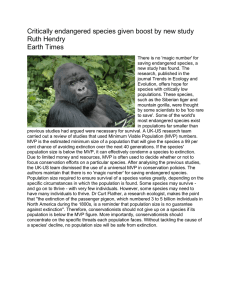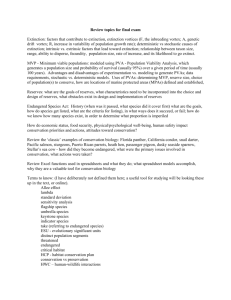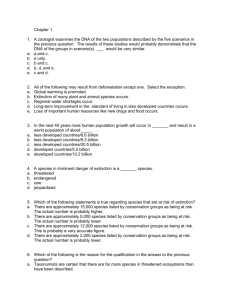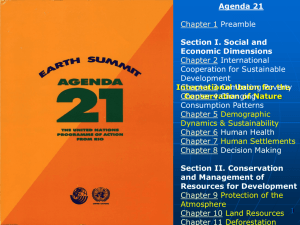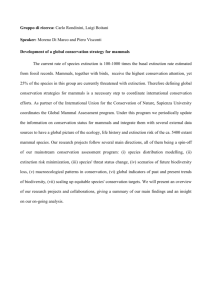486 Write Back in determining a population’s viability (Lande 1993; Caughley 1994; Flather
advertisement
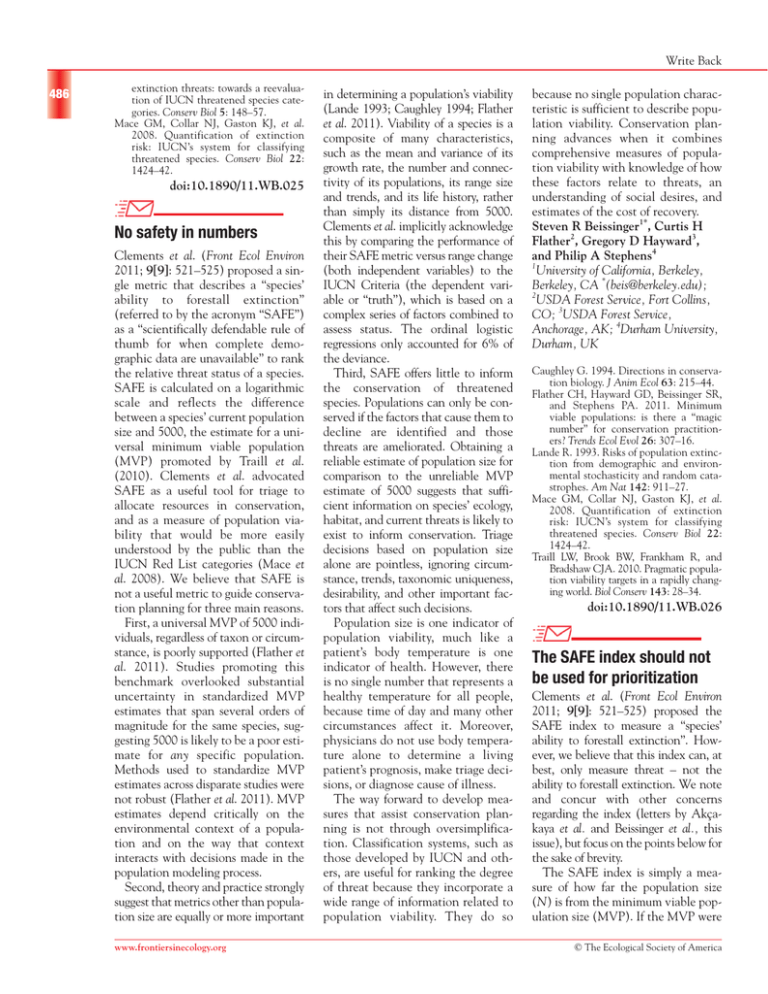
Write Back 486 extinction threats: towards a reevaluation of IUCN threatened species categories. Conserv Biol 5: 148–57. Mace GM, Collar NJ, Gaston KJ, et al. 2008. Quantification of extinction risk: IUCN’s system for classifying threatened species. Conserv Biol 22: 1424–42. doi:10.1890/11.WB.025 No safety in numbers Clements et al. (Front Ecol Environ 2011; 9[9]: 521–525) proposed a single metric that describes a “species’ ability to forestall extinction” (referred to by the acronym “SAFE”) as a “scientifically defendable rule of thumb for when complete demographic data are unavailable” to rank the relative threat status of a species. SAFE is calculated on a logarithmic scale and reflects the difference between a species’ current population size and 5000, the estimate for a universal minimum viable population (MVP) promoted by Traill et al. (2010). Clements et al. advocated SAFE as a useful tool for triage to allocate resources in conservation, and as a measure of population viability that would be more easily understood by the public than the IUCN Red List categories (Mace et al. 2008). We believe that SAFE is not a useful metric to guide conservation planning for three main reasons. First, a universal MVP of 5000 individuals, regardless of taxon or circumstance, is poorly supported (Flather et al. 2011). Studies promoting this benchmark overlooked substantial uncertainty in standardized MVP estimates that span several orders of magnitude for the same species, suggesting 5000 is likely to be a poor estimate for any specific population. Methods used to standardize MVP estimates across disparate studies were not robust (Flather et al. 2011). MVP estimates depend critically on the environmental context of a population and on the way that context interacts with decisions made in the population modeling process. Second, theory and practice strongly suggest that metrics other than population size are equally or more important www.frontiersinecology.org in determining a population’s viability (Lande 1993; Caughley 1994; Flather et al. 2011). Viability of a species is a composite of many characteristics, such as the mean and variance of its growth rate, the number and connectivity of its populations, its range size and trends, and its life history, rather than simply its distance from 5000. Clements et al. implicitly acknowledge this by comparing the performance of their SAFE metric versus range change (both independent variables) to the IUCN Criteria (the dependent variable or “truth”), which is based on a complex series of factors combined to assess status. The ordinal logistic regressions only accounted for 6% of the deviance. Third, SAFE offers little to inform the conservation of threatened species. Populations can only be conserved if the factors that cause them to decline are identified and those threats are ameliorated. Obtaining a reliable estimate of population size for comparison to the unreliable MVP estimate of 5000 suggests that sufficient information on species’ ecology, habitat, and current threats is likely to exist to inform conservation. Triage decisions based on population size alone are pointless, ignoring circumstance, trends, taxonomic uniqueness, desirability, and other important factors that affect such decisions. Population size is one indicator of population viability, much like a patient’s body temperature is one indicator of health. However, there is no single number that represents a healthy temperature for all people, because time of day and many other circumstances affect it. Moreover, physicians do not use body temperature alone to determine a living patient’s prognosis, make triage decisions, or diagnose cause of illness. The way forward to develop measures that assist conservation planning is not through oversimplification. Classification systems, such as those developed by IUCN and others, are useful for ranking the degree of threat because they incorporate a wide range of information related to population viability. They do so because no single population characteristic is sufficient to describe population viability. Conservation planning advances when it combines comprehensive measures of population viability with knowledge of how these factors relate to threats, an understanding of social desires, and estimates of the cost of recovery. Steven R Beissinger1*, Curtis H Flather2, Gregory D Hayward3, and Philip A Stephens4 1 University of California, Berkeley, Berkeley, CA *(beis@berkeley.edu); 2 USDA Forest Service, Fort Collins, CO; 3USDA Forest Service, Anchorage, AK; 4Durham University, Durham, UK Caughley G. 1994. Directions in conservation biology. J Anim Ecol 63: 215–44. Flather CH, Hayward GD, Beissinger SR, and Stephens PA. 2011. Minimum viable populations: is there a “magic number” for conservation practitioners? Trends Ecol Evol 26: 307–16. Lande R. 1993. Risks of population extinction from demographic and environmental stochasticity and random catastrophes. Am Nat 142: 911–27. Mace GM, Collar NJ, Gaston KJ, et al. 2008. Quantification of extinction risk: IUCN’s system for classifying threatened species. Conserv Biol 22: 1424–42. Traill LW, Brook BW, Frankham R, and Bradshaw CJA. 2010. Pragmatic population viability targets in a rapidly changing world. Biol Conserv 143: 28–34. doi:10.1890/11.WB.026 The SAFE index should not be used for prioritization Clements et al. (Front Ecol Environ 2011; 9[9]: 521–525) proposed the SAFE index to measure a “species’ ability to forestall extinction”. However, we believe that this index can, at best, only measure threat – not the ability to forestall extinction. We note and concur with other concerns regarding the index (letters by Akçakaya et al. and Beissinger et al., this issue), but focus on the points below for the sake of brevity. The SAFE index is simply a measure of how far the population size (N) is from the minimum viable population size (MVP). If the MVP were © The Ecological Society of America
